Professional Project Uploaded
Easy all. Professional Project uploaded to separate blog at:
http://partizandovey.wordpress.com/
Partizan Project Links:
Pogo’s Facebook profile – http://www.facebook.com/partizanproject
Facebook Group – http://www.facebook.com/group.php?gid=100093830459&ref=ts
Facebook Event – http://www.facebook.com/event.php?eid=85257722115
Myspace page – http://www.myspace.com/partizanproject
Pogo Scratch 1 – http://mediaweb.aib.ac.uk/fdashow09/dovey/pogo_scratch_1.mov
Pogo Scratch 2 – http://mediaweb.aib.ac.uk/fdashow09/dovey/pogo_scratch_2.mov
Pogo Scratch 3 – http://mediaweb.aib.ac.uk/fdashow09/dovey/pogo_scratch_3.mov
Pogo Drum and Bass – http://mediaweb.aib.ac.uk/fdashow09/dovey/pogo_drum_and_bass.mov
Pogo Dubstep – http://mediaweb.aib.ac.uk/fdashow09/dovey/pogo_dubstep.mov
Professional Unit – ‘The Partizan Project’

This project is perfect for me, as it concentrates on all the areas I’m particularly interested in. As the night is real event, I also gain valuable experience in many areas, such as dealing with clients and costings. The launch night is on 20th June 2009 at the Empire Club in Bournemouth, and hosts a range of music talent from across the UK, from Drum and Bass, Dubstep, Electro and more.
For the work side of things I have set up a separate blog to deal with entire unit, located at http://partizandovey.wordpress.com/.
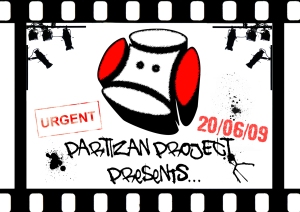
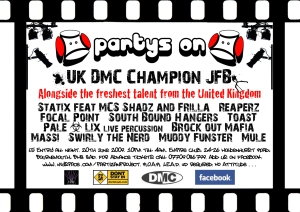
PPRD 2 – CV
Duvstar12@hotmail.com
http://mediaweb.aib.ac.uk/fdashow09/dovey
07845 279 568
I am a hard working team player who strives for perfection in everything I do, and settles for nothing less. Attention to detail is everything. I never give up on a task, as without a challenge where is all the fun? I have confidence in my abilities to work both with people and directing people. I have a passion for music and motion graphics, and feel the two co-exist side by side. I am currently co-organising a new event around Bournemouth called the ‘Partizan Project’, which we have big plans for in the future.
Education
Arts Institute Bournemouth 2009 – 2010
BA Hons Digital Media Production
Arts Institute Bournemouth 2007 – 2009
FdA Interactive Media & Web Design
Isle Of Wight College 2005 – 2007
Triple Distinction – BTEC Nat Dip Graphic Design
Carisbrooke High School 2004 – 2005
C (AS Level) – Geography
Carisbrooke High School 2001 – 2004
A – Art, A B – English (double award), B B – Science (double award), B – Graphic Design, B – History, C – Mathematics, C – French, C – Religious Education
Work Experience
Counter Assistant, J Sainsbury’s PLC, Isle of Wight/Boscombe (dual store contract) April 2004 – Present
Duties include customer service and interaction, dealing with people and organisation of multiple counters. Multi skilled across a range of departments, including Deli, Meat and Fish, Food to Go, checkouts and replenishment. Have worked part time throughout education.
Achievements
– Won most promising young tennis player on Isle of Wight at age 11
– Won Island County Schools Cricket Championship in 2001
– Won Island wide DJ competition to play at the Bestival in 2008, runners up 2007 and 2006. Bestival has won many awards for best medium sized festival of the year.
– Won ‘Not So Silent’ DJ competition in Bournemouth, 2008
– Played at ‘Destiny’ in 2009, a well established drum and bass event
– Gained 5 year service badge from J Sainsbury’s in 2009
– Working towards organisation and promotion of a co-owned music event in Bournemouth – ‘The Partizan Project’
PPRD 2 – Career Plan
My ultimate goal is to own my own musical/graphical empire, ranging from event promotion to music production. This will specialise in many forms of media, mainly motion graphics, VJ’ing, music production, film and promotional material. Personally I shall specialise in music production and motion graphics, ultimately combining the two, which will lead into VJ’ing.
This course is the bridge I need to start my four step plan, as the qualification and contacts you meet in university and even from moving town can be priceless in developing potential. Gaining as much knowledge from this degree as possible is essential in pushing me to aspire. I think a realistic target for all this to happen by is the age of 25 in 2013.
Step 1 – Promoting the Partizan
As part of my professional unit, and self interest, I have recently organised and promoted a music event called the ‘Partizan Project’, with the launch night happening 20th June 2009 at the Empire Club. The event boasts 4 genres of music, including turntablism, drum and bass, dubstep and electro, and we have a range of well established artists playing.
As well as organising the event I also created the promotional material, including posters, flyers and CD covers. This is an area of design I have always been interested in, and one I specialised in whilst studying at college. Its also an area I shall try to keep a hand in throughout my career. The next step is to concentrate on some contemporary motion graphics aimed at promoting the event on the web, as it concentrates a huge majority of our target audience together in one place, and the better presented your ideas the more professional they look and the more people notice. I see this as a natural progression, demonstrated by my Motion Graphics unit. I had huge pleasure in completing that unit, and feel I did extremely well. I’ve always had quite an interest in Typography so this unit really hit home. Its because of this I see myself developing skills within the industry.
Step 2 – Learning new skills
The first step is out of the way, the posters and flyers have been printed, the acts have been booked and the travels been arranged, all that’s left to do now is hope the event goes to plan!
As the idea is an on-going thing, there will be many more events down the line. The second step is too learn new skills such as video editing and motion graphics software, as well as music production software, hopefully ending up with a competent knowledge of a range of applications such as Ableton Live, Logic 8, After Effects and the Creative Suite, as well as a range of hardware objects.
This should lead to a natural progression into VJ’ing, which is an area I’m still working up to. I’ve always felt music and graphics exist side by side, so this is an area that encourages me. At the moment I have a rudimentary knowledge of this side of media, and that’s something I want to change. Producing the music myself is also an important aspect of my overall goal.
Although I have developed my skills over the past two years of this course, there is still much I don’t know about a lot of things, unfortunately many of them to do with the area I want to go into. In this last year of the course it is imperative I manage to learn as many skills as I can, gaining a proper understanding of them to help expand my creativity.
Step 3 – Expanding the Partizan
Once the night has an established reputation around Bournemouth, the next step would be to expand the event across the country, starting with the south in areas like Brighton, Southampton, Winchester and the Isle of Wight, and spreading onwards and upwards through Bristol, Bath, London and even up to Birmingham and beyond. The skies the limit as they say.
This would also be the time to think about expanding into more niche music genres, possibly splitting the night to cater for different genres. There are many areas we can branch off into, the rave scene, the live music scene and of course, the electronic scene. Festivals are also an option. Generally creating the ultimate music experience.
By this point in the plan I should have gained a much better understanding of the new software I will have been working on and will be creating visuals, possibly light shows, to go with my sets. I shall also hopefully be well on the way to creating my own music, which I can then include in the sets. At this point I shall also be able to create music videos to accompany the tunes, which is another area the VJ skills will help. From here the company could also start creating music videos and installation VJ sets for promotional materials.
Step 4 – The complete Partizan package
If all goes to plan up to now I shall have almost completed step 4 before I start it! Basically, step 4 is the complete event package, a smoothly running regular event held up and down the country with the biggest names across a wide range of music genres. I shall still have a hand in all the organisation and design work, as well as creating my own unique live musical experiences where I produce an audio/visual set to showcase at the events.
But it could even be so much more than that, a complete promotions company, even a record label right down to a school for DJ’ing and developing young talent. For all this to happen would be more like a 10 – 15 year plan, but its possible, and most importantly, achievable.
PPRD 2 – 2nd Year Reflection
My first year wasn’t the best year of study I’ve ever accomplished, although to an extent I feel that’s always the case when something new is involved, as it takes some time to adjust. The second year is where it all starts to connect. The main goals for this year were to gain much more technical knowledge of the software I intend to use (music production and graphics/motion graphics), as well as gaining a proper plan for my next steps in life after the course. To a certain extent this has been achieved, although due to mitigating circumstances I haven’t been able to focus as well as I would have liked too of during crucial periods of the year. This has been an unfortunate stress on my mind, which I do believe has had a negative effect on my work completed over these times.
The year started really well with some innovative and exciting projects, mainly the Motion Graphics unit. The brief looked to utilise all the skills I had gained studying Graphic Design at college, typography, use of space and balance and timing, something I know all about as a DJ. I chose something I would stay enthusiastic about, a drum and bass track called Deep by TC (Roni Size Remix). It’s fast, exciting and keeps the listener on their toes whilst appealing to the right target audience.
Because the lyrics are so fast I decided early on not to complicate things with imagery, and as this was kinetic typography that worked just fine. The main focus of the work would be the transitions between words and the attention to detail when considering timing and font choice. I spent many a late night trawling trough type fonts to find the right ones for the right words. But this pleased me in ways; attention to detail is something I’ve always been strangely interested in.
The process of making it was intense from start to finish. As well as the number of words I had to animate, I wanted each one to come in perfectly in time. This was a majorly important aspect in the success of the piece, as it would have looked rubbish out of sync. Key framing each movement was time consuming to say the least, and then working out how each composition would link together smoothly was at times near impossible. But I stuck at it, and was so pleased with the final outcome. I feel it’s precisely what I wanted to achieve and it almost couldn’t have gone better. I just wished I could have done it to the whole song!
After Effects was also a program I really wanted to expand my knowledge on, and the tutorials we had really helped develop my understanding of the program, however minimal it may still be. I feel much of my work in future will use After Effects, and next year will concentrate on progressing even further in the area.
Advanced Web Design was a unit I was originally dreading, although by the end found it quite a challenge. I have to admit, this is something I’m not usually interested in and so found it hard to gain enthusiasm at first, although as we got into it it became more interesting. I still wouldn’t pursue a career in it but it certainly developed my knowledge in something I knew very little about. There are many cool things you can do with coding I’m sure but it’s just something I don’t find hugely interesting.
The unit focused on developing our understanding of Action Script 3, and whilst it did do this, I still don’t understand it to a comfortable level. The logic behind it’s fine; it’s the definitions and structure I can’t seem to grasp. A complete dictionary of terminology with explanations would be immensely helpful when learning coding.
The brief asked us to pull an RSS feed from the Internet, which would then transform a set of random graphics using Action Script in Flash. As the feed would need as many changing numbers as possible I chose to pull a feed from the Premier League table, using the clubs emblems as the images. From the table I picked the teams overall points, number of games played and goals scored as the information used to manipulate the images. After much tweaking of the code, it almost did what I wanted it to do, although the unit was not about the final piece, it was about starting to get to grips with coding.
In complete opposite to Advanced Web Design, the Sky project looked fun and imaginative whilst still firmly industry based. The brief was to come up with the next step in Sky Interactive entertainment, something new and out of the box. Our group’s idea focused on two areas, a social networking site and motion tracking control of the interface. At first it sounded sweet, but from the feedback we got it soon became clear there was only one thing we should be concentrating on, the social networking aspect. This for me is the natural progression in how company’s connect with their customers, as the demand for on demand viewing services and social networking sites will only continue to grow as time passes, so why not merge them? I honestly believe this could make a huge amount of money for a company like Sky, and feel it’s only a matter of time before something like this is made.
The unit was presented to Sky for real at their base in London. It was an incredibly useful insight into working with a client in real life, and I think we all learnt a lot from the opportunity. One of the main things I learnt from the unit was the power of a good presentation. It’s so much easier to express your ideas when you have a real understanding of what you want to say. I was pleased with the feedback we got from Sky; they agreed it certainly seemed like the next step in online entertainment and feet if the idea was developed it could be a huge success.
It was when we got the briefs through for the Professional unit things started to go wrong. At first it took me ages to figure out what I wanted to do, and then I needed to save £400 for the software I needed to complete it. The original idea was to create a short DJ mix using Ableton Live, with an accompanying VJ style promotional video for the purposes of distribution. By the time I had saved the money and made the mix (which was incredibly fun to make using Ableton, I’d had my doubts as a vinyl DJ but great program, worth every penny), I’d had a family bereavement and was in an unfit state to complete my work.
In ways this helped me understand where I actually wanted to go. I needed the kick to get me doing what I always to do, organise and promote my own music event. This quickly became a reality, and so it seemed the sensible thing to do would be to incorporate that into my Professional unit. As well as organising the event, I designed the promotional material and will complete a short promotional video and a set of motion graphic pieces for promotional uses on the web. This is a live project, and will give me bags of experience where I wouldn’t gain any otherwise. I’m fully committed, the flyers are printed and the acts are booked, it has my full enthusiasm and I want that to translate to the course. This is also a long-term plan, as we plan more events in the future.
Another added bonus to this is as we get more of a reputation we can start introducing visuals to the equation. I’d love to try VJ’ing and this could be a goal I can focus on achieving throughout my final year on the course. I feel this is something I can really get my teeth into and contains many prospects for progressing my technical abilities in areas I’m interested in. We have plans to expand to areas such as Brighton, Bristol and London, and there is even scope to produce media such as magazines and mix CD’s, and events such as festivals given the right business plans and appropriate time. As this unit is still ongoing and won’t be handed in till august there will still be much to reflect upon after completion, although even then it won’t be over. The work will be based upon the first night and it’s promotional material only.
I feel there is much still to learn over the next year, and much I heed to do to progress my career plan into a reality. I definitely feel it’s possible and within reach, it all hinges on the progression of my technical abilities to achieve my overall goal. The focus will be on motion graphics and VJ’ing, with promotion and event organising as a side project for live experience. I also aim to start music production as I feel this is another aspect I need to learn in order to complete an all round set of skills that should assist me through my professional life.
Refining and Defining – Introduction
Computer generated graphics for movies have always interested me, ever since I saw the likes of Toy Story and Jurassic Park as a child. The attention to detail is something I find strangely interesting; it’s so intricate and looks so elegant on screen. There are many types on CGI used in today’s movies, and a diverse range of movies rely on it to make them successful. People want to see cutting edge, high budget graphics that give that extra edge, it’s big money.
CGI stands for Computer Generated Imagery. It involves applying 3D computer graphics and special effects to films as well as other forms of media. 3D models are created, whilst movement is performed just like a normal motion picture, at set of frames running around 24 to 30 frames a second, slightly faster than normal, which contain computer generated imagery and appear to come to life. This can be digitally composited over traditional camera motion pictures to add special effects or can be used to make entire movies like Toy Story and Kung Fu Panda. It’s so popular because it’s more controllable than traditional processes, and more cost effective. Plus it looks fresh and feels contemporary, something that always helps to sell things to a target audience.
CGI is essentially the digital successor to traditional illustration and stop motion animation techniques, although is based on the same principles. 3D modelling allows the user to create figures that can be completely controlled by use of a skeleton, where as 2D figures are put together from layers that can be individually manipulated. There are many software applications widely used within industry, including Maya, 3ds Max, After Effects and Blender, all of which have different uses.
Background
CGI was first used in movies like Futureworld and Star Wars IV in the early 1970’s, for basic animations that are almost unrecognisable next to today’s examples, even in it’s relatively brief history. The techniques are developing so fast it’s hard to keep up. An early film to delegate a large budget to CGI was Tron (1982), which failed commercially, leading directors to only use CGI imagery for specific reasons.
CGI did not win over its audiences until The Abyss was released in 1989, when it won the Academy Award for Visual Effects. It was from here CGI really started to make an impact on movies, taking a central role on Terminator 2 (1991). In Jurassic Park (1993), dinosaurs were created with CGI and placed seamlessly into live action scenes, wowing audiences worldwide, and Toy Story (1995) was the first feature length movie to be made entirely from CGI using 3D modelling. It was a revolution for the film industry, the transition it needed to transform traditional animation into computer-generated imagery.
CGI has proved itself as a high profit industry, grossing on average 20% more than it’s traditional counterparts. It has quickly become the norm for special effects; the technology has progressed so much so there is almost no need for props and doubles. The success of CGI can be seen in many of today’s Hollywood blockbusters, like The Lord of the Rings trilogy (2001 – 2003), Kung Fu Panda (2008) and Watchmen (2009).
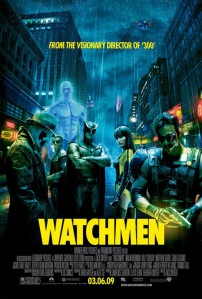
Refining and Defining – Current Situation
Different Techniques
There are many techniques involved within Computer Generated Imagery, all using different Software and Hardware applications to create the desired effect. They include digital compositing, green screen (Chroma Key), motion graphics, computer animation and IMAX technologies. For the purposes of this essay I shall concentrate on two areas for case studies, the green screen and computer generated animation/3D modelling.
The green screen, or blue screen, works by filming actors in front of a bright, single coloured screen so digitally enhanced backgrounds can be used instead of filming on location. The whole process is relatively cheap to produce, and because of this the process is widely popular. Green and blue are used as they are deemed the furthest away from human skin colour; although green is preferred as image sensors in cameras are more sensitive to green. The computer-generated backgrounds are then put in place by selecting the screen colour and replacing it with the imagery, a process known as ‘keying’. Clothing plays a big part in the process, as they cannot be the same colour as the screen otherwise they will be deleted when the scene is edited.
Computer generated imagery is evident in many of today’s movies. It can range from special effects on action movies to movies made completely from CGI. Personally I find CGI in movies to be a huge selling point, the better the graphics the more chance I’m going to see it. As I will be looking at Toy Story as a case study, I shall focus on 3D modelling.
3D modelling consists of characters/objects generated from a series of manipulated edges, faces and vertices programmed to move be the use of a skeleton and a set of joints. Movement is controlled by keyframing in a timeline. ‘Skins’ are then attached to the models to give them the desired effect when rendered. Models can contain literally hundreds or control points; ‘Woody’ from Toy Story contains 700 alone.
Popularity/Successful Movies
CGI is in use in most movies that come out in the current market. Some directors do still chose to film all their footage traditionally for the purposes of the film, although the majority use at least small elements of CGI to touch up the final edits if not produce the majority of the film. I feel this is a good thing, especially with the advancements in technologies available. I like the crisp, clean feel you get with computer-generated imagery, I like the modern stylised look to the movies, and I feel the techniques will only grow more popular, even more so with the successes of the Frank Miller comic book adaptations like Sin City (2005) and The Spirit (2008).
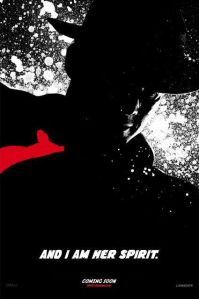
Refining and defining – Case Study
Sin City
Sin City was shot using all green screens, apart from 3 sets for specific shots, using a film noir throughout. It’s extremely stylistic and contemporary, and is possibly my favourite movie. The director wanted to translate the comic book as much as possible and I feel this is achieved perfectly; the shots look exactly like they were taken from the comic. Honestly, I love the style.
The film was shot using a High Definition digital camera on a digital backlot, and was one of the first films to do so. The combination of these elements makes Sin City one of the few live action fully digital movies. Although the film has been made primarily film noir, colourization is evident in some scenes, such as the red dress from the opening scene and the yellow skin colour of Roark Junior, the ‘Yellow Bastard’.
The attention to detail in staying faithful to the original comic is evident throughout, every measure possible has been taken to retain the comic book look and feel, every aspect is based entirely on the original. Even though Miller had no experience in directing, he was a valuable asset to the production of the film as he had the greatest vision of how the movie should look, he wrote the original.
I feel it’s Miller’s overall take on the film that really makes it work. The passion him and Rodriguez put into the movie is translated in the outcome, every little detail ties together to produce an engaging experience for the audience. It really is like reading the comic. If anything it looks too stylistic, which can put some people off, which I feel is it’s only downfall.
The film gained largely positive reviews, particularly online; James Berardinelli placed the film in his top ten films of 2005. Some said they have pushed comic book films as far as they can go now, which to an extent I feel is true, although it’s the style that’s more important to me. It’s just simply aesthetically pleasing. Others were quick to criticise it, saying it an “adaptation depicting castration, murder, torture, decapitation and rape”. At the end of the day, it’s a comic book adaptation.
Sin City grossed $29.1 million on its opening weekend, ultimately ending its North American run with $74.1 million. The film grossed $84.6 million overseas, taking a grand total of $158.7 million worldwide.
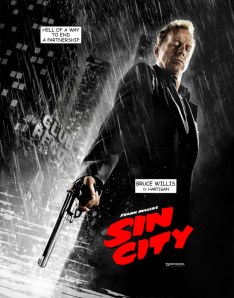
Refining and defining – Case Study
Toy Story
Disney Pixar Studios made Toy Story in 1995. It was the first film to be fully completed using only Computer-Generated Imagery. Previous animated movies had been more expensive and required more personnel to make, Toy Story was made on a $30 million budget and utilised 110 animators where as The Lion King needed $45 million and 800 animators. Disney Pixar also spent $20 million on marketing the film, with sponsors ranging from Coca-Cola to Burger King. This proved to be a huge marketing prospect. But lets not forget it was the technology behind it that really made Toy Story what it was.
Each character was first modelled using a computer, then transferred into the animation. Motion and morphing controls are added to allow each character to move freely, whilst speech is synchronised by detailed manipulation of the characters faces. Visual effects, lighting and shading are added just before rendering. The attention to detail involved is possibly more incredible than in Sin City, as one tiny mistake could cost dearly if not picked up in time. I’ve tried 3D modelling and it’s not easy.
Personally I have huge admiration for the movie, as it was a pioneer in a wave of computer-generated movies that I always find hugely entertaining. I think most adults still find them appealing as they touch a sub conscious nerve reminding them of their own childhood, something everyone enjoys now and again.
Mainstream critics across the globe have praised the movie for it’s innovative approach to computer animation and ability to appeal to every age group, a massive target audience. Time magazine named Toy Story 8th in their list of the top ten films of 1995, and in 2005 the movie was selected for preservation in the United States National Film Registry, one of only five films to do so in it’s first year of eligibility.
The top grossing film on it’s opening weekend, Toy Story grossed over $191 in the United States and Canada alone, taking more than $356 million worldwide and staying in cinemas for 37 weeks. The film was so successful it prompted a sequel which became even more successful than the first, and now has it’s own brand of promotional merchandise.
In comparison to Sin City, Toy Story is massively more successful in almost every way. It doesn’t rely on a sub-genre to sell itself, it’s an all round fun time kids movie that appeals to a huge target audience, where as Sin City only appeals to a certain age group and enthusiast, which is always a tough crowd to crack. Toy Story was also more revolutionary; it broke boundaries where Sin City had none to break. It made the style more popular no doubt, but it had been seen and done before and until the next revolutionary movie like Toy Story comes out, only the best movies in this genre will be deemed as classics.
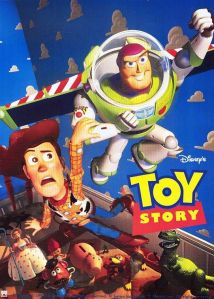
Refining and Defining – Future Scenarios
Will all films be made using CGI one day?
I firmly believe that one day 95% of movies will be made using some form of CGI. I think there will always be scope for traditionally shot scenes at least, but the majority will be done using computer as its so much cheaper and can be made perfect at the touch of a button. I feel there will be three main areas, CGI animations like Toy Story, green screen productions like Sin City, although not set in a comic book style, and 3D movies. 3D movies like ones shown at IMAX cinemas have yet to make the big stage, although I feel that will logically be the next step in movie entertainment, demonstrated recently with the release of My Bloody Valentine: 3D Home Edition (2009). One day all films will be 3D, with a realistic viewing experience made to feel like you’re actually in the movie.
Production company’s such as Disney Pixar, Dreamworks Studios and Blue Sky Studios will continue to push animated movies to the next level, and with the imminent release of movies such as Shrek Forever After (2010), Toy Story 3 (2010) and Ice Age: Dawn of the Dinosaurs (2009), the effects and publicity will only get bigger and better.

What’s next for CGI?
With the increase in render speeds alongside the advancements in software applications it’s only a matter of time before designers can work at home on industry standard equipment just like they were in an office. At the moment, advancements in render speeds progress at the same speed as new, more complex effect modules, meaning rendering hasn’t got much faster over the last few years. This can only change as new, more powerful operating platforms are developed.
Photorealistic human animation is another obstacle for animators. Due to the extreme complexity of the human body, realistic simulation of human behaviour is still largely undoable. One day animators will be able to control a fully photorealistic human character interacting with it’s surroundings so that it is next to impossible to tell it’s not a real person.
